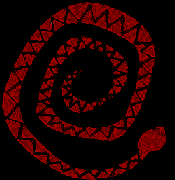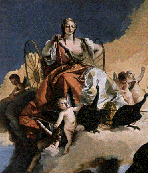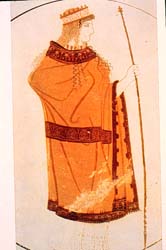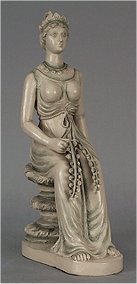The White Moon Gallery Presents
HERA
Great Mother Goddess
Hera is the goddess who has suffered the most at the hands of those who dabbled in Greek mythology. Summed up and dismissed as a shew and a nag, Hera was in fact the most powerful of all the Olympian goddesses, the queen of the gods. Before that she was the primary divinity of the pre-Hellenic Greeks who honored her through festivals similar the Olympics.
Long before the Indo-European Hellenes came down from the north to occupy the land and islands of Greece, a Mediterranean race, speaking a language different from the Hellenes, occupied Greece. The older race which are called Minoan and Early Hellenic, had customs and codes different from those of the incoming Hellenes. The older culture was, for example, matriarchal. Society was build around the woman; even on the highest level, where descent was on the female side.
A man became king by formal marriage and his daughter succeeded. Therefore the next king was the man who married the daughter. Until the Northerners arrived, religion and custom were dominated by the female and the Goddess.
Hera was the chief divinity of this culture; she was their queen and ancestral mother, and she ruled alone, needing no king to back her up. The earliest evidence about her describes her as Queen of Heaven, great Mother Goddess, ruler of people. In these images, she was associated with the bird, the snake, and the bull, suggesting connections with water, earth, and life energies.



HERA'S TRIPLE PHASES
The ancient Hera passed through three stages: youth, prime and age. First she was the maiden Hebe or Parthenia, called virginal not because she avoided intercourse but because she had no children and was free of responsibility. In this stage she was also called Antheia ('flowering one'), symbol of both the flower of human youth and the budding earth in springtime.
Next she revealed herself as the mature woman, Nymphenomene, ('seeking a mate') or Teleia ('prefect one')'; she was the earth in summer, the mother in her prime of life.
Finally she showed herself as Theria ('crone'), the woman who has passed through and beyond maternity and lives again to herself.
In all these stages, she represented the epitome of woman's strength and power. Far from being spiteful and malicious, she was generous and self-assured. The ancient Hera was so beloved that being recast in such negative aspects in the myths created by the conquering northern Hellenes, she was still worshiped and revered. It seems the women refused to give her up entirely. In spite of the slanderous tales about her, she would emerge at festivals in her honor as a goddess who cared for women.

SYMBOLS OF HERA
Hera has three symbols which can be connected with her three ancient phases. The first of these is the cuckoo, a bird in many places connected with springtime. Later myths frequently mentioned that Hera had a tender spot for the cuckoo. At Mycene, a Creatan colony, on the Greek mainland, miniature temples mounted with cuckoos have been found buried in the rubble along with statuettes of a naked goddess holding the same birds on her arms. As Hera's worship goes back to that period, these statutes may represent her most ancient worship.
Another symbol of Hera is the peacock. Hera's watchfulness is symbolized by the peacock and the 'eyes' in its feathers. The bird was a sacred symbol of Hera and wandered the in temples of Hera. In addition, the peacock is often associated with summer and therefore this may symbolized Hera's second phase, the mature woman, the mother phase.
The third symbol for Hera is the pomegranate which she shares with Persephone. She is often depicted holding the pomegranate but there is no reference in her myths to its significant. Ripening late in the year, the leathery-skinned pomegranate, so full of juicy seeds, is a marvelous image for a woman in her late years, her crone years. The deep red juice of this fruit was often likened to blood and in some areas of Greece, was designated as food for the dead, heightening this connection to her crone phase.
Others symbols for Hera include lilies and cows. In ancient Greece at Hera's temple in Argos, her priestesses gathered lilies of the valley and garlanded her alter with them. The lily is a powerful symbol of the feminine and can be given as an offering to honor the goddess and to invoke her presence. The cow, a less frequent symbol of Hera, was associated with her because she was said to have cow eyes, and disguised herself as a cow in one myth. Also cows were often sacrificed to her. Hera's cow identity shows her to be a heavenly goddess ruling the celestial vault and its luminaries.
Another symbol with Hera is the apple. At Her forced marriage to Zeus, Hera was given a special magic garden in the West where she kept Her apples of immortality. This magical garden was called the Hesperides, probably a symbol of Her regenerating womb; Her apples were guarded by Her sacred serpent.

TO BUILD A HERA ALTAR
Cuckoos and peacocks are relatively difficult to come by in most areas, so other symbols can be used instead.
If you keep an eye out tho, you may find little figurines in toy stores or in shops that carry small china figurines.
For Hebe, the goddess aspect in springtime, you can use instead a spray of flowers, lily of the valley is you have them; for Teleia the summer goddess, a piece of ripe summer fruit, like an apple or a peacock feather suffices. And her own chosen symbol of her crone phase, the pomegranate, is usually available in most grocery stores. If you cannot find a pomegranate, a piece of rock or weathered wood can stand in for this phase of the goddess as Thera, the crone.
Display these objects on a background of blue, for the sky that was Hera's earliest abode. Place a candle in front of each of the symbols that represent Hera's multiple phases

FEASTS AND RITUALS FOR HERA
In honor of the three phases of Hera, the ancient residents of Greece celebrated the Heraea, a competitive festival that dates to earlier times than the Olympics. Every four years - and later, on the full moon of
August, every year - women came to a field near Hera's town of Argos for the 160 yard races. They ran bare-breasted and with hair unbound, in three age groups to honor the goddess' s three stages. There were three winners, each receiving identical olive crowns and a share in the cow sacrificed at the festival. Each winner had the right to leave a statuette of herself in Hera's shrine.
Hera's other great festival was her annual. Her worshipers bathed her image, renewing her youth and preparing her again for the seasonal cycle of vegetative maturation and death. Carrying the goddess's statue to the water to cleanse the winter from her marked how they, like the earth, would forever be reborn. Unfortunately, the date for his ritual has been lost, although it would make symbolic sense if the renewal celebration were held in spring. As goddess of women, Hera could be appropriately invoked today on International Women's Day, March 8th.
WHY I CHOSE THIS GODDESS
It there is a goddess of feminism, it surely must be Hera. For she represents what happens to women's power in a world unwilling to acknowledge it. While men can say what they want and be authoritative; a woman is called greedy if she expresses her wants and desires - she is demanding and carping is she expresses authority. Even today, women who command power are often demonized just like Hera was in Greek myths. An earlier generation, men and women, mocked Eleanor Roosevelt for being plain , derided for being outspoken. Hera, hung from the sky in the Greek myths, is an all too-vivid image of women being pilloried for having power and inner authority - and showing it. It is satisfying to restore dignity to this ancient Goddess. She has survived ages of abuse to her reputation and her myths but is re-emerging today as an inspiring figure of strength and dignity.
SOURCES
The Goddess Pat by Patricia Monaghan
The Goddess Companion by Patricia Monaghan
Embracing the Goddess by KrisWaldherr
Altars Made Easy by Peg Streep
The Goddess Speaks by Dee Poth
Awakening Your Goddess by Liz Simpson
365 Goddesses by Patricia Telesco
Women's Dictionary of Symbols and Sacred Objects by Barbara Walker
Maiden, Mother, Crone by D. J. Conway
Internet Link:
http://www.lunaea.com/goddess/power
This site has a beautiful collage of Hera, and gives links to other sites........
These sites give the typical Greek mythology about Hera:
Http://www.loggia.com/myth/hera.html
Http://apk.net/~fjk/hera.htm/#Basi
Back to Gallery
Join a School







